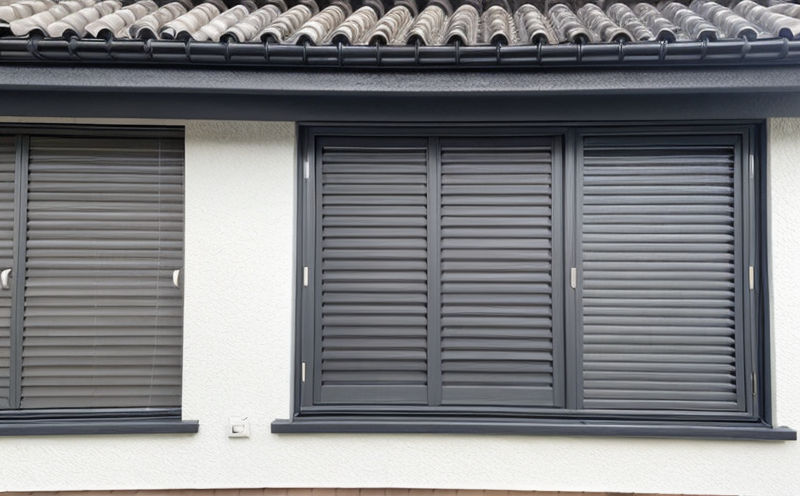Shutter and blind installation inspection
In the construction and building sector, shutter and blind installations play a crucial role in enhancing both the aesthetics and functionality of buildings. These systems not only provide essential privacy but also contribute to thermal insulation, light control, and acoustics. Shutter and blind installation inspection ensures that these elements are installed correctly, efficiently, and meet specific quality standards.
The inspection process involves thorough examination of the shutter and blind components before they are integrated into a building's structure or facade. This includes verifying the compatibility with existing materials, ensuring proper alignment and fit, and assessing structural integrity. Quality control is paramount to ensure that shutters and blinds function optimally under various environmental conditions.
Inspection criteria for shutter and blind installations typically align with international standards such as ISO 9001:2015 for quality management systems, ASTM C786-14 for thermal performance of building materials, and EN 12797-3 for window shutters. Compliance with these standards is essential to ensure that the installed products meet regulatory requirements and contribute effectively to energy efficiency.
The inspection process begins with a detailed review of project specifications and design plans. This ensures that all components are compatible with the intended use and comply with architectural and environmental considerations. Field inspections then follow, focusing on the installation quality, alignment, and overall fit within the building's framework. Proper installation is critical to achieving expected performance in terms of thermal insulation, acoustic control, and aesthetics.
Accurate and reliable data collection during inspections is crucial for subsequent analysis and reporting. This includes measurements of gaps between shutters or blinds and their frames, checks on alignment with adjacent surfaces, and assessments of any potential structural impacts. Reporting must be comprehensive, highlighting both successful installations and areas requiring remediation to ensure compliance with regulatory standards.
Quality managers and compliance officers play a vital role in overseeing this inspection process, ensuring that all aspects are meticulously documented and reviewed against established criteria. For R&D engineers and procurement professionals, understanding the nuances of shutter and blind installation can lead to innovative design solutions and more efficient supply chain management strategies.
Why It Matters
The importance of shutter and blind installation inspection cannot be overstated in modern construction practices. Properly installed shutters and blinds can significantly enhance a building’s energy efficiency, contributing to reduced heating and cooling costs while improving occupant comfort.
- Thermal Insulation: Correctly positioned shutters and blinds help maintain indoor temperature stability by blocking heat gain in summer and retaining warmth during winter.
- Acoustic Control: These systems also play a key role in reducing noise pollution, providing a quieter environment for occupants.
- Privacy and Safety: Ensuring that shutters and blinds are installed securely enhances privacy while offering enhanced security measures through better control over access to the interior.
From an environmental perspective, energy-efficient installations contribute positively towards sustainable building practices. Compliance with relevant standards not only ensures regulatory adherence but also promotes a greener construction industry. For businesses involved in procurement and R&D, understanding these aspects can drive innovation and efficiency improvements across various stages of the design and build process.
Quality and Reliability Assurance
The quality and reliability assurance (QRA) in shutter and blind installation inspections are critical to achieving optimal performance. This involves a systematic approach that encompasses several key aspects:
- Pre-inspection Review: This phase includes reviewing project specifications, design plans, and ensuring all components align with intended use.
- Field Inspection: Detailed examination of installed shutters and blinds focusing on alignment, fit within the framework, and overall structural integrity.
- Data Collection: Accurate measurement of gaps between shutters/blinds and frames, checks on alignment with adjacent surfaces, and assessments for any potential structural impacts.
- Reporting: Comprehensive documentation highlighting both successful installations and areas needing remediation. Reporting must be aligned with relevant standards such as ISO 9001:2015 and EN 12797-3.
The use of advanced tools like laser scanners and thermal imaging cameras enhances the precision and reliability of these inspections, ensuring that every installation meets the highest quality standards. Compliance with international standards ensures consistency across projects, contributing to a more sustainable and efficient construction industry.
Use Cases and Application Examples
| Application Example | Description |
|---|---|
| Residential Buildings: | Ensuring that shutters and blinds are installed correctly to enhance privacy, thermal insulation, and aesthetics. This application is particularly relevant for multi-story residential complexes where energy efficiency plays a significant role. |
| Commercial Spaces: | Incorporating blinds into office buildings to manage natural light effectively while maintaining occupant comfort. This example highlights the importance of acoustic control in reducing noise pollution within busy urban environments. |
| Schools and Universities: | Installing shutters in educational facilities to protect sensitive equipment from sunlight damage, improve acoustics for better learning experiences, and enhance overall environmental comfort. |
- Healthcare Facilities: Using blinds and shutters in hospitals to maintain patient privacy while ensuring staff can control light levels effectively. This application underscores the critical role of these systems in enhancing both patient care and operational efficiency.
- Luxury Hotels: Implementing high-end shutter solutions that not only enhance aesthetics but also contribute significantly to energy savings through superior thermal insulation properties.
In each of these applications, proper installation is key to achieving the desired outcomes. Compliance with relevant standards ensures that installations are reliable and perform as expected in real-world conditions.





